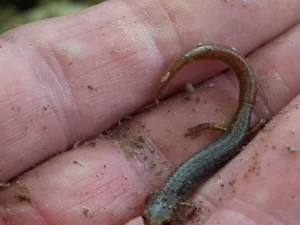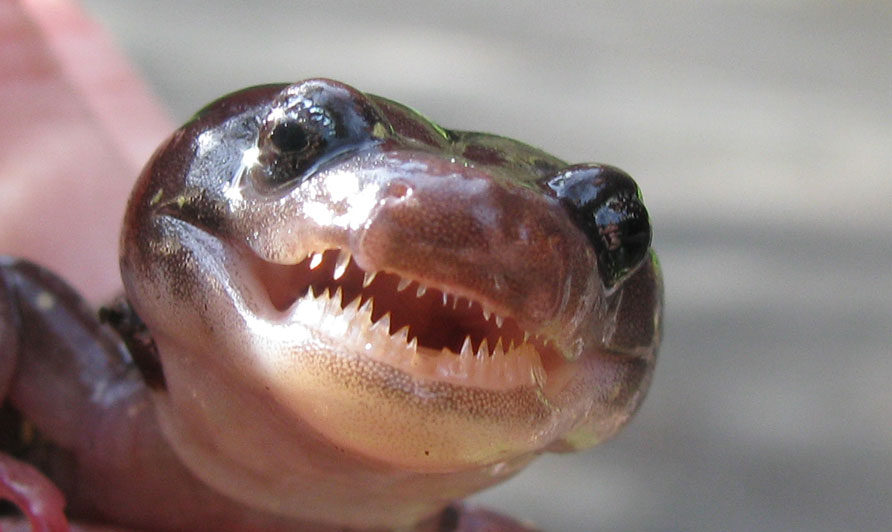When people think of wild animals, scary images often pop into their minds. Many imagine creatures that could hurt people. But salamanders are very different from those scary animals. They are quiet, gentle amphibians who live both on land and in water.
Salamanders do not attack humans. They are small, shy animals that want to stay safe, not fight. If you see a salamander, it will usually try to hide or run away, not come near or bite you.
How Salamanders Interact With Humans
Salamanders are calm and gentle. They spend most of their time hiding from other animals. They do not look for fights or try to hunt big creatures. Instead, they focus on finding food and staying safe.
These small amphibians are very different from what many people imagine. They are not bold or aggressive.

Usually, salamanders avoid contact with other animals, including humans. When a salamander sees a person coming, it will almost always try to hide or quickly run away.
For salamanders, staying safe is the main goal. Fighting can be dangerous for such small creatures, so they avoid it.
This careful way of living has helped salamanders survive for millions of years. They know hiding is better than being bold or aggressive.
This is why they behave very differently from scary animals you see in movies or hear about in stories.
How Do Salamanders Protect Themselves?
When salamanders feel scared, they do not fight back. Instead, they use other ways to stay safe.
The first thing salamanders do when threatened is to hide. They are very good at finding small spaces like under rocks, logs, or leaves.
Some salamanders can change their color a little to blend in with their surroundings, making them very hard to see.
Another way salamanders stay safe is by staying very still. Many predators look for movement when hunting. By freezing, salamanders can avoid being noticed.
Some salamanders have an amazing ability: if a predator grabs their tail, they can drop it and run away. The tail will grow back later. This may sound painful but is much better than being caught.
A few salamanders make chemicals in their skin that taste bad. These chemicals don’t hurt predators but make salamanders unappealing to eat.

This helps them avoid being eaten without fighting.
Common Wrong Ideas About Salamanders
Many people have wrong ideas that make them scared of salamanders. Let’s look at some of these myths and the truth behind them.
One myth is that salamanders are poisonous. Most salamanders are not. Some do produce bad-tasting chemicals, but these chemicals do not harm humans unless eaten; which almost never happens.
Another myth is that salamanders are aggressive and will attack people. This is false. Salamanders are peaceful and try to avoid fights.
Some people think salamanders are related to lizards or snakes. They are not. Salamanders are amphibians, more closely related to frogs and toads. They have moist skin and usually live near water, unlike reptiles.
Another wrong idea is that salamanders carry diseases dangerous to humans. While it’s good to wash your hands after touching wild animals, salamanders are not known to spread harmful diseases to people.
When Might a Salamander Seem Defensive?
Even though salamanders are peaceful, sometimes they act in ways that might seem defensive.
For example, if you try to pick up a salamander, it might wiggle and try to escape. It might also release slippery mucus. This isn’t an attack; it’s just the salamander trying to get away from danger.
Sometimes, a salamander may open its mouth when scared. This looks threatening but is only a way to try to look bigger and scare off danger. It’s not planning to bite.
If you disturb a salamander’s home, such as by moving a log, the salamander might come out into the open looking for a new hiding spot. This increased activity is not aggression but confusion and fear.
Very rarely, a salamander might bite if handled roughly. But their teeth are tiny and cannot hurt humans. They bite only as a last resort when they cannot escape.
Why Salamanders Are Important
Salamanders play important roles in their ecosystems.
One big job they do is controlling insect populations. They eat mosquitoes, flies, and bugs that can damage crops. By doing this, salamanders help keep insect numbers low.
Salamanders also serve as food for other animals like birds, snakes, and small mammals. This makes them a vital part of the food chain.
Scientists study salamanders to learn about the health of the environment. Salamanders are sensitive to pollution and changes in their homes. Healthy salamander populations usually mean a healthy environment. When salamander numbers drop, it often signals environmental problems.
When salamanders die, their bodies add nutrients to the soil. This helps plants grow better. The insects they eat also become part of the soil’s nutrients. This shows how salamanders help keep nature balanced.
What to Do If You See a Salamander
If you see a salamander, there are good ways to enjoy the moment while keeping both you and the salamander safe.
The best thing is to watch from a distance. Salamanders are interesting to observe as they move and behave naturally without being disturbed.
Avoid trying to catch or hold the salamander. Your hands can harm their delicate, moist skin. Handling can also stress them and make them sick.
If you find a salamander inside your home, don’t panic. It is probably just looking for a cool, damp place to hide. You can gently guide it outside using a piece of paper. Avoid using your hands.
Taking photos is a great way to remember the experience without disturbing the animal. Just keep a respectful distance.
If you find a salamander that seems hurt or sick, contact local wildlife experts. They know how to help salamanders safely. Trying to help by yourself might cause more harm.
Living Peacefully with Salamanders
Salamanders and humans can live close without problems. These quiet creatures are so small most people don’t even notice them. When you do see salamanders, simple steps help keep everyone safe.
Respect their space. Salamanders need quiet places to live. If you know salamanders live nearby, leave wild spaces in your yard for them to hide and find food.
Be careful when working in your yard. Check under logs, rocks, and leaf piles before moving them. If you find salamanders, leave them alone, they will move on.
Teach children about salamanders. Help them understand these are gentle creatures that should be watched from afar, not touched.
Consider yourself lucky if salamanders live near you. Their presence means your local environment is healthy. Sadly, many places have lost salamanders due to pollution and habitat loss.
Conclusion
Salamanders do not attack humans. These small, gentle creatures are far more afraid of us than we are of them. They spend their lives hiding and avoiding danger.
Salamanders are peaceful animals with important jobs in nature. They help control insects and serve as food for other wildlife. They also help scientists understand environmental health.
When we know the truth about salamanders, we can respect and protect them. They are not dangerous monsters or attackers, but quiet, gentle animals deserving our care.
Hi, my name is Ezra Mushala, i have been interested animals all my life. I am the main author and editor here at snakeinformer.com.

